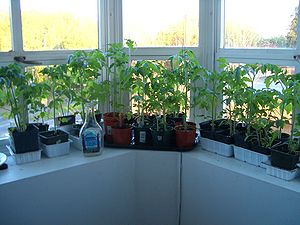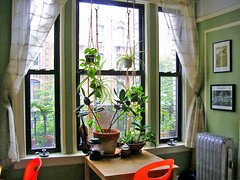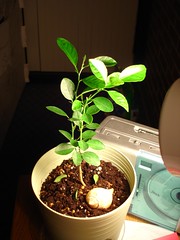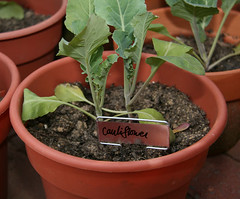Certain plants are obviously more suited than others to your aim of growing vegetables indoors. Large plants that enjoy colder climates, like the brassica family or leeks, are not the best choice for growing in a small apartment. Most root vegetables require a deeper depth of soil than you probably want to provide. However, if you have a large apartment that does not have heating directly under the windows, you can grow larger plants by placing rectangular containers on the floor in front of your windows.
Herbs are a very popular choice for people growing vegetables indoors because many of them are small plants that will grow happily on a windowsill. Herbs like fresh air and you will probably find they grow better if you can leave a window slightly open for them during the day, as long as the weather is not too cold. They also prefer well-drained soil so they are best watered little and often.
 |
| Growing your own vegetables in containers means you can move them indoors or outdoors as needed. (Photo credit: Wikipedia) |
It is important to choose the right containers for your plants. A seedling starts out very small but it can grow into a large plant. In order to avoid disturbing it later, it is best if, after germination, seedlings are transferred into the container appropriate for the final plant.
You will also need to think about what to put in the containers. While plants will happily grow in regular earth outside, they need more nutritionally-adapted soil to grow indoors. This is because they do not have the benefit of all of the microorganisms and other nutrients that are available in the deep beds outside. So you will need to buy compost or soil that is suitable for the specific plants that you are planning to grow. You cannot necessarily use the same compost for everything. For example, there are many brands of compost designed specifically for tomato plants.
Of course, your lifestyle can be the difference between success and failure when growing vegetables indoors. Plants in containers dry out very easily, and the more shallow the container, the truer this is. If you spend a lot of time away from home for work or social reasons, you may find it difficult to give your plants the water and other care that they need, unless you have a friendly neighbor who will take care of them for you.
Even more important are the conditions inside your home. If you have a north-facing apartment with small windows, it will be difficult for your plants to get enough sunlight. You will have to choose them very carefully to produce any worthwhile crops.
However, if you keep these points in mind, there is no reason why you should not have an indoor garden to be proud of. With a little care and planning, most apartment or city dwellers can enjoy all the benefits of successfully growing fresh vegetables indoors.















